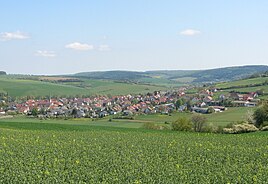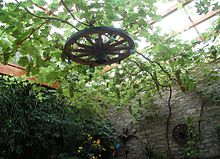Stetten (Karlstadt)
|
Stetten
City of Karlstadt
|
|
|---|---|
| Coordinates: 49 ° 56 ′ 39 ″ N , 9 ° 49 ′ 52 ″ E | |
| Height : | 187 m |
| Residents : | 1067 (Jan. 1, 2020) |
| Incorporation : | January 1, 1978 |
|
View of Stetten
|
|
Stetten is a wine village in Lower Franconia . It is a district of Karlstadt am Main in the Main-Spessart district . Stetten has 1067 residents (as of January 1, 2020).
history
With remarkable finds from prehistory and early history, the place is one of the oldest settlements in the Werntal .
788 was the first documentary mention of Stetten (then Steti) (lat. Loci, liuti dero stetsi). For Stetten, the written tradition begins with the Matton donation to the Fulda monastery in 788.
"" Cum igitur cives [Hs. ciues ] loci vidissent eum dederunt ei sodales triginta qui essent cum eo (Idc 14,11; Gl I: 388, 26) Gen. Sg. St. F. stat 'Place' “ Text glossary. "
816 grapevines were planted in the Rosstal .
In 1311 the parish church of St. Albanus was mentioned. 1500 Stetten winery owners, on the "Stein" and in the "Rosstal", are taxpayers to the city in the Karlstadt district . The Julius Echter church tower was built in 1612 . In 1625 there were 290 deaths from the first plague in Stetten. 1632 which took place plunder Stetten in Sweden war .
In 1690 the archway (today's landmark ) was built. In 1870, Stetten was badly affected by emigration due to the prevailing economic conditions .
On January 1, 1978 it was incorporated into the city of Karlstadt, and in 1985 the land consolidation was completed. Starting from this year, Stetten has continuously developed into a wine village. In 2000, Silvia Gaul was elected Franconian Wine Queen .
economy
The wine-growing has a long history in Stetten, already in 1540 it was with a cultivation area of about 200 ha as one of the most "wine nests" in the Bishopric of Würzburg referred. The village's main livelihood suffered severe setbacks at the end of the 19th century. Vine diseases and pests almost brought viticulture to a standstill. The merger to form a winegrowers' cooperative in 1937 provided stimulating impetus .
The work in the vineyard , all family members were involved, was increasingly being replaced by new types of machines.
Citizens in Stetten
Stetten was badly affected by emigration due to the prevailing miserable economic conditions.
- 1850-1920
The three- generation family (everyone lived under one roof) used to include grandparents, parents and their children. This type of family was lost and has become increasingly rare to this day, especially since many families did not even have the necessary space. The town's population register recorded only 910 citizens in 1928. Today Stetten has 1055 inhabitants. Over the course of almost 80 years, probably also due to increased family planning since the 1970s (birth control pill), only a small increase was recorded.
Attractions
- Catholic Church of Saint Albanus
- Archway to the church castle from 1691
- Stetten herb garden
- Stetten Wine Trail, a delightful circular trail through the Stetten vineyards. At the beginning of the hike there are slight climbs to be mastered. A wonderful view of the Main valley opens up at the Roßtal . From there the path continues over the Kürbishöhe back to the starting point.
Club culture
In Stetten there are many different clubs that enrich both sporting and cultural life.
Spielvereinigung Stetten e. V. (SpVgg Stetten)
In 1927, two decades before the Spielvereinigung 1946 e. V., there was already a football team called Spielvereinigung, which was renamed DJK in 1929 and banned by the Nazi regime in 1933. In the difficult time after the Second World War , young men who were enthusiastic about sports got together again and on April 13, 1946 founded the Stetten game association. The first soccer game was played on May 1, 1946. The club is divided into the following departments: football (founded in 1946), chess (1965), badminton (1991), table tennis (1979), gymnastics (1980) and hiking (1979). Youth work is a major concern of the gaming association. The average number of members is around 600.
Fruit and horticultural association
The fruit and horticultural association has set itself the task of beautifying the place. For this purpose, various places in cities are decorated with flowers and plants. The OGV operates a herb garden, the construction of which began in 1992. The garden is right on the bike path to Gemünden am Main and is accessible at all times. About 120 different medicinal, aromatic and culinary herbs grow on an area of approx. 400 m².
Stetten Volunteer Fire Brigade
In 1875 the Stetten volunteer fire brigade was founded. In addition to the active fire brigade, young people are promoted.
Winegrowers Association
Among the achievements of the winegrowers 'association are the wine cellar , built in 1953, which today houses a branch of the Franconian regional winegrowers' cooperative (GWF) and a wine trail through the various Stetten vineyards. In 2000 Silvia Gaul was Franconian Wine Queen .
Carnevals Club Stetten (CCS)
The CCS with its penalty councils organized two annual ceremonial meetings . Many local young women are represented in the various gardens of the association.
Edelweiß choral society
Men and women sing in the Edelweiß choir founded in 1906.
literature
- Edgar Burkard: 1200 years of Stetten , published by Stadt Karlstadt a. Main, 1988.
- Heßlar / Stetten: Verlag Gerhard Kralik, Karlstadt 2004. ISBN 3-9808818-6-5
- Social differences in the number of children, text from: Weiss, Volkmar and Katja Münchow: Local family books located in Leipzig in the German library and German central office for genealogy. 2nd Edition. Neustadt / Aisch: Degener 1998, pp. 117–121
Individual evidence
- ↑ Numbers, data, facts. City of Karlstadt, archived from the original on March 30, 2020 ; accessed on March 30, 2020 .
- ^ Federal Statistical Office (ed.): Historical municipality directory for the Federal Republic of Germany. Name, border and key number changes in municipalities, counties and administrative districts from May 27, 1970 to December 31, 1982 . W. Kohlhammer GmbH, Stuttgart and Mainz 1983, ISBN 3-17-003263-1 , p. 763 .






